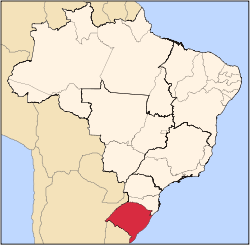This article needs additional citations for verification .(December 2019) |
Cachoeirinha | |
|---|---|
| Motto: A New City | |
 Geographical divisions of Rio Grande do Sul state. Cachoeirinha is highlighted in red. | |
| Coordinates: 29°57′03″S51°05′38″W / 29.95083°S 51.09389°W | |
| Country | Brazil |
| Region | Sul |
| State | Rio Grande do Sul |
| Founded | 15 May 1966 |
| Government | |
| • Mayor | Cristian Wasem Rosa (MDB) |
| Area | |
• Total | 43.9 km2 (16.9 sq mi) |
| Elevation | 17 m (56 ft) |
| Population (2022 [2] ) | |
• Total | 136,258 |
| • Density | 3,100/km2 (8,040/sq mi) |
| Time zone | UTC−3 (BRT) |
| CEP | 94900-000 |
| Area code | (+55) 51 |
| Website | Official website |
Cachoeirinha (lit. "Little Waterfall") is a city in the Brazilian state of Rio Grande do Sul. Cachoeirinha is an alternative for the people who want to be near Porto Alegre (capital of Rio Grande do Sul). The city is situated at a strategic point in Rio Grande do Sul state. The city shares borders with Porto Alegre, Canoas, Esteio, Sapucaia do Sul, Gravataí and Alvorada. The city holiday is on May 15, the date on which the city declared its emancipation.
Contents
Cachoeirinha is known locally for having a large industrial district, for being the new home of Esporte Clube Cruzeiro, a traditional football team from Rio Grande do Sul, and for housing the Rice Experimental Station of the Rio Grande do Sul Rice Institute (IRGA). [3]




